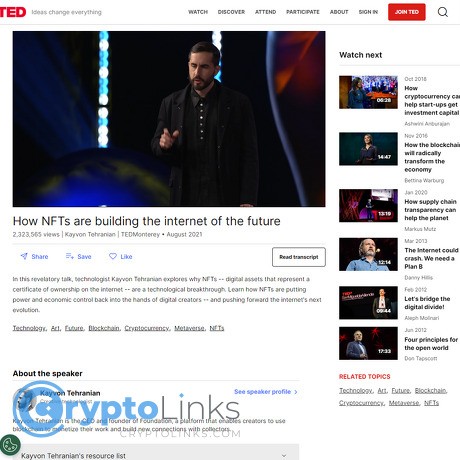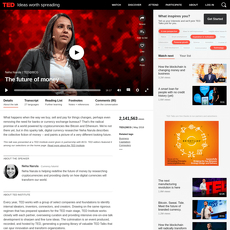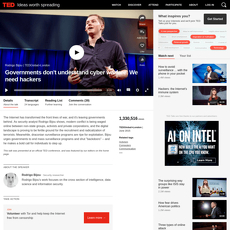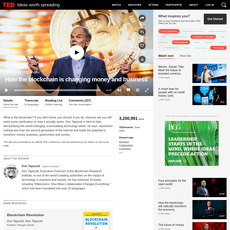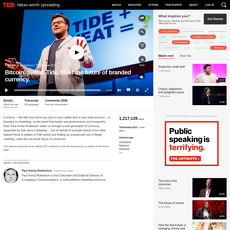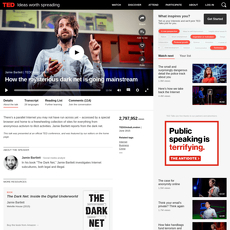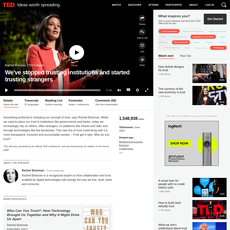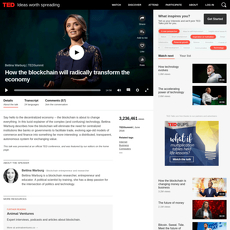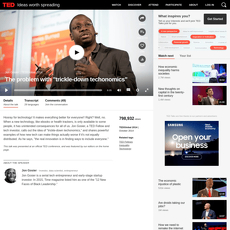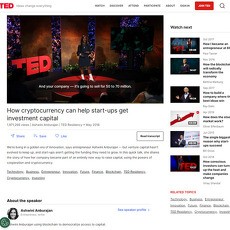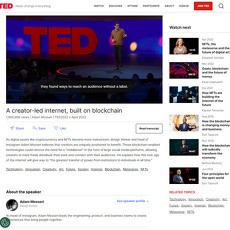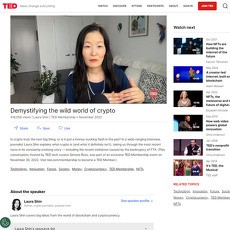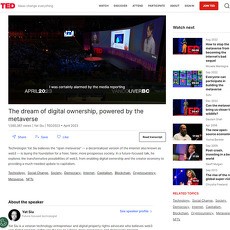Kayvon Tehranian: How NFTs are building the internet of the future Review
Kayvon Tehranian: How NFTs are building the internet of the future
www.ted.com
Kayvon Tehranian’s TED Talk on NFTs: The Internet of the Future (Full Review, Guide + FAQ)
What if you could actually own a piece of the internet you help create—your audience, your work, your income—without begging a platform for permission?
That’s the hook behind Kayvon Tehranian’s TED talk on NFTs, and it’s why this topic matters far beyond speculation. In simple terms, it’s about shifting power from platforms to people. Not with slogans, but with tech that lets you own your digital stuff and carry it anywhere.
The problem with today’s internet (and why creators feel boxed in)
Right now, big platforms set the rules, keep the data, and control the rails for making money. If you post, stream, or publish for a living, you already know the story:
- Rented reach: One algorithm change and your traffic falls off a cliff. In 2018, a joint Buffer + BuzzSumo analysis of 43 million Facebook posts found a major slide in engagement for brands—down by roughly 50% year over year. That wasn’t a creator problem; it was a platform decision that rewired outcomes for everyone.
- Shifting fees and policies: When Patreon rolled out a fee change in 2017, it hit both creators and supporters hard enough that the company published a “we messed up” apology. That’s the reality of building on someone else’s rails.
- Demonetization heartbreak: On video and social platforms, eligibility rules and ad policies can change overnight. If your income depends on those toggles, you’re one review away from zero.
It’s not that these platforms are evil—they’re just centralized. They own the account system, the audience graph, and the business model. You publish inside their box and play by their rules. If you leave, you start over from scratch.
The internet we have: access without ownership.
The internet we want: access with ownership.
That’s the punchline in Kayvon’s talk: the promise of an “internet of ownership,” where your identity, your audience, and your assets live in your wallet—not in a company’s database. Whether you’re a photographer selling limited editions, a musician offering memberships, or a collector backing early work, the core idea is the same: portability and control.
My promise to you
I’m going to keep this practical and no-BS. By the time you’re through the full piece, you’ll know:
- The big idea behind NFTs from this TED talk—explained in plain English
- Real pros and cons (no hype, no doom)
- What’s actually happening under the hood, without confusing jargon
- How to start safely, avoid traps, and make smart first moves
What this guide covers
- A clear summary of the talk
- Quick answers to the questions everyone asks
- A simple, safe getting-started plan
- The tech explained in a way that clicks
- An honest review of the vision vs. today’s reality
- A short FAQ and concrete next steps
Where to watch the talk
Kayvon Tehranian: How NFTs are building the internet of the future (TED)
If the problem is centralized control and rented reach, how exactly do NFTs flip the script to user ownership? Let’s unpack that next—and I’ll show you what changes the minute your wallet becomes your account.
The core message of Kayvon’s talk: from platform ownership to user ownership
Here’s the shift Kayvon makes crystal clear: the internet’s power shouldn’t sit in a company’s database—it should sit in your wallet. When ownership moves from platforms to people, creators stop “renting” audiences and start carrying them anywhere they go. That changes the rules of how culture, money, and communities work online.
“Ownership online means freedom—freedom to move, to earn, and to build without asking for permission.”
What are NFTs in this context?
Not hype, not just art drops. In this frame, NFTs are unique digital assets defined by smart contracts—public pieces of code that record who owns what, how it moves, and sometimes what it unlocks.
Think of an NFT as a portable, programmable receipt you actually control. It can point to media, grant access, or represent membership, and it lives at your address—not a platform’s mercy. The standards behind them (like ERC‑721 and 1155) are open, so any app can recognize the same asset.
- Art and culture: A piece by an artist you love that also grants you entry to private releases or events.
- Music and rights: Tracks sold directly to fans with on-chain proofs of ownership; platforms like Sound have paid millions to independent artists through direct support.
- Memberships: A token that unlocks a Discord, a newsletter, or a yearly gathering using tools like Collab.Land and tokenproof.
- Tickets and perks: Token-gated presales and loyalty benefits already tested by big brands and live events, with ecommerce support like Shopify’s tokengated commerce.
- Mass adoption signals: Reddit’s Collectible Avatars brought millions of everyday users into wallet-based ownership—without asking them to learn crypto jargon first.
Why it matters: once an asset is in your wallet, apps compete to serve you. That flips the web’s default power dynamic.
How NFTs shift power
When your identity and assets are wallet-first, platforms become interfaces—not gatekeepers. You aren’t starting from zero every time you try a new app; you’re signing in with your inventory and your community already attached.
- Portability: Your audience is on-chain. If you token-gate a community today and move platforms tomorrow, your supporters don’t vanish—you still recognize the same holders.
- Composability: New tools can plug into your existing tokens without permission. A gallery, a merch store, a game—if it supports the standard, your NFTs work there.
- Market choice: You choose where to list, socialize, and sell. Assets can flow across marketplaces instead of being trapped inside one company’s UI.
- Aligned incentives: Apps win by offering better experiences, not by holding your audience hostage inside their walled garden.
We’ve seen the early version of this with social logins—easy, but centralized. Wallets push it further: they’re login, inventory, and reputation in one, and you hold the keys.
Why this matters for creators
Creators have been paying the algorithm tax for a decade. NFTs introduce direct-to-fan rails that feel a lot like Shopify did for ecommerce: own your store, own your data, own your revenue.
- Direct sales: One-click mints or limited editions go straight to your supporters without handing off 30% to an app store or guessing what a feed wants today.
- Programmable perks: Tokens can unlock behind-the-scenes access, private livestreams, geofenced events, or collector-only merch—all verifiable by the holder’s wallet.
- Royalties where supported: On-chain signals like EIP‑2981 let marketplaces recognize your requested royalty rate. It’s not perfect everywhere, but the idea—recurring support without middlemen—is already real on some venues.
- Community-funded careers: Fans aren’t just followers; they’re patrons and collaborators. Early supporters get status, utility, or a share of cultural upside. Projects like Royal (fans backing artists with on-chain proofs of ownership) and token-gated tours point to what’s possible.
- Open data = resilience: If a platform shutters or changes rules, your holders and your history still exist on-chain. That safety net didn’t exist before.
There’s growing evidence this model sticks beyond hype cycles. The 2024 State of Crypto report by a16z shows onchain usage and L2 adoption trending up, lowering costs and opening doors for more everyday use cases. And on the mainstream front, Reddit proved that millions of users will jump in when the UX meets them where they are.
Key takeaways from the talk
- Wallets are universal accounts: One identity you control, portable across apps and platforms.
- Assets are building blocks: NFTs are not endpoints; they’re primitives other apps can build on—games, galleries, storefronts, and communities snap into the same standard.
- Markets form around creators: Instead of creators plugging into platform markets, platforms swarm to serve assets creators issue. Power flips.
- Ownership is leverage: When you carry your work and your audience with you, you negotiate from strength—not dependence.
Still wondering if this is all just fancy JPEG talk or how ownership is actually “proven”? I’m about to break that down in simple English, with the biggest myths and the real answers next. Ready for the no-BS version?
Quick answers to the most asked questions about NFTs (in plain English)
“Are NFTs just JPEGs?”
No. The picture, audio, or video is just the media. The NFT is the record that says who owns it and what it can do.
- Think of the media as the art, and the NFT as the receipt + rules written into a smart contract.
- That contract can define supply, provenance, access rights, and even perks like event access or downloads.
- Real example: Reddit’s Collectible Avatars aren’t “just images.” They’re portable badges of membership and identity that work across apps because they live in your wallet.
“The file is the art; the NFT is the deed.”
“How do NFTs prove ownership?”
Ownership is tracked on a public ledger (blockchain). Your wallet address is listed as the owner. Transfers are timestamped and verified by cryptography—no one can quietly edit the record.
- Every sale or transfer is visible on-chain, creating a public provenance trail.
- Standards like ERC‑721 and ERC‑1155 let any app check “who owns what” without asking a platform for permission.
- Want to verify? Paste the NFT’s contract address into a block explorer (e.g., Etherscan) and you’ll see owners and transfers in plain sight.
“Are NFTs bad for the environment?”
Ethereum moved from Proof‑of‑Work to Proof‑of‑Stake in 2022, slashing energy use by roughly 99.95% according to the Ethereum Foundation.
- Source: ethereum.org/energy-consumption
- Many NFTs now live on efficient networks like Polygon or Ethereum L2s (Base, Optimism, Arbitrum), which keep costs and energy extremely low.
- Bottom line: the energy profile of minting or trading an NFT on modern networks is closer to sending an email than running a server farm.
“Are NFTs a fad?”
Speculation cycles are noisy, but the underlying primitive—verifiable digital ownership—keeps finding useful, boring, everyday jobs.
- Tickets & access: Ticketmaster has tested NFT ticket stubs and on-chain access.
- Loyalty: Starbucks Odyssey uses NFT “stamps” for rewards and experiences.
- Identity & communities: Reddit avatars and token-gated Discords make perks portable across apps.
- Media: Musicians use platforms like Sound and Royal to sell music and fan-backed rights.
Do prices swing? Absolutely. Do useful ownership rails stick around? Also yes.
“How do creators actually make money?”
Short answer: by selling ownership, access, or experiences that live in a wallet—often with programmable rules.
- Primary sales: Sell a limited collection or 1/1s directly to fans.
- Royalties (where supported): Some marketplaces honor creator royalties via standards like EIP‑2981. Not universal, but still common in creator‑first markets.
- Memberships: Token-gated communities, updates, or livestreams that check for NFT ownership.
- Unlockables: Files, stems, prints, or behind‑the‑scenes content unlocked by holding the NFT.
- Brand & collab drops: Limited runs with partners (think merch, experiences, or co‑branded art) baked into smart contracts.
Example path: a photographer sells a 100‑edition series, grants holders access to a private “process journal,” and offers first dibs on future prints—no middleman needed.
“What’s the risk?”
The tech is powerful—and unforgiving. The biggest threats aren’t the chains; they’re social engineering and bad UX.
- Phishing & wallet drainers: Fake mints and “urgent” DMs lure you into signing malicious transactions. If you didn’t initiate it, don’t sign it.
- Blind signing: Avoid signing unknown approvals (watch for functions like setApprovalForAll). Use wallets that show human‑readable details.
- Storage mistakes: Lose a seed phrase and you lose access. Keep it offline, split if needed, never type it into a website.
- Platform risk: Custodial marketplaces can fail or freeze withdrawals. Self‑custody reduces that single point of failure.
- Rug pulls & fakes: Always verify contract addresses and creator profiles. Check collection history and community signals.
Helpful read: Chainalysis Crypto Crime Report shows scams remain a leading threat. The fix is discipline: hardware wallets, trusted links, and a “sign nothing you don’t understand” rule.
Gut check: You deserve to actually keep what you earn and build online. That’s the point. Ready to take the first step without getting burned? In the next section, I’ll walk you through the exact wallet setup and safe‑start checklist I use—want the 5‑minute version or the thorough one?
Your action plan: how to get started safely after watching the TED talk
I want your first step into NFTs to feel exciting, not stressful. Here’s the exact playbook I use when I help friends set up, buy their first piece, or mint their first drop—minus the fluff, with the safety rails on.
“Not your keys, not your art.”
Set up your wallet
Pick a wallet you can actually live with day to day, then add a hardware wallet for anything you care about keeping long term.
- Daily wallet (hot): MetaMask on desktop. If you’re more advanced, Rabby shows simulations before you sign—great for avoiding bad transactions.
- Long-term storage (cold): Ledger or Trezor. Connect it to MetaMask/Rabby and keep it unplugged unless you’re moving assets.
- Seed phrase backup: write it on paper or use a metal backup, store in two separate places, and never type it into a website or share it with anyone. Ever.
- Basic hygiene: install from official sites only, bookmark your wallet and marketplaces, and turn on phishing protection/transaction insights in settings.
Pro tip: create two wallets. One “vault” (hardware) and one “burner” (hot). Use the burner for minting and experiments; move anything valuable to the vault.
Fund your wallet
Start tiny. You’re practicing, not flexing.
- Buy ETH on a trusted exchange like Coinbase or Kraken.
- Withdraw to your wallet address (paste carefully; consider sending a $5 test first).
- Pick your chain: Ethereum mainnet costs more but is the most established; Layer-2s like Base are cheap and fast. Many exchanges now let you withdraw directly to Base/Arbitrum/Optimism.
Reality check: gas on Ethereum can swing from a few bucks to more at busy times; L2s are usually cents. If you’re just getting started, L2s are friendlier.
Explore marketplaces
Before you click “buy,” verify what you’re seeing. Here’s my 60-second checklist:
- Marketplace: browse Foundation (creator-first), OpenSea (broad selection), or Blur (pro trading tools). Filter by chain you funded.
- Contract address: click through to the contract and open it on Etherscan (or the explorer for your chain). Does it match the project’s official website/X/Discord?
- Collection history: check sales/activity, number of holders, and if the creator’s wallet is public and active. Sudden spikes with zero community chatter = caution.
- Warnings: if a marketplace flags a collection for suspicious activity or stolen items, trust that signal.
Toolbox: add Revoke.cash to your bookmarks now. It lets you remove risky token/NFT approvals you’ve granted in the past.
Make your first purchase
Keep it small and intentional. You’re buying a piece of culture, access, or utility—not a lottery ticket.
- Start with low-cost mints on L2s or claimable open editions (Zora, Base) to learn the flow without stress.
- Verify you’re buying the right item: token page should show the correct contract address and chain. If the creator lists a “v2” contract, confirm that publicly.
- Understand the rights: some NFTs are CC0 (open), others are personal-use only, and a few grant commercial rights. If terms aren’t clear, ask or pass.
- Check liquidity/interest: look at recent sales and listing depth. If you might sell later, thin liquidity means slower exits.
- Avoid OTC DMs: no “private deals,” no clicking links from strangers. If it isn’t a known marketplace page, skip it.
Good first-buy targets: artist editions under $20 on Base, a claim from a creator you already follow, or an event NFT where the utility is clear (token-gated Discord, early drops, or livestreams).
Mint your first NFT (for creators)
If you make stuff—art, music, writing—here’s the simple route to your first mint.
- Pick a platform: Zora Create (fast on L2s), Manifold (power tools, own your contract), or OpenSea Studio (no-code).
- Choose format: 1/1 (ERC-721) for single works; editions (ERC-1155) for accessible pricing. Start with editions if you want more collectors early.
- Prep media + metadata: aim for web-friendly file sizes; store media on IPFS or Arweave. Platforms often handle this for you—make sure they show a content hash.
- Set supply and pricing: fixed price or a limited-time window. Keep it simple on your first drop.
- Royalties: set your preferred percentage (commonly 5–10%). Some marketplaces respect on-chain royalty signals, others don’t—so plan for primary sales and memberships too.
- Announce clearly: post the official contract address, mint link, and rights in one pinned tweet/post and in your bio. Reduce confusion, reduce scams.
Example path I’ve seen work: an edition of 50 on Base via Zora, media pinned to IPFS, $5–$15 price, clear utility (collectors get a private Q&A or early access). Low gas, low friction, happy first collectors.
Security basics you can’t skip
Chainalysis has shown that scammers steal billions every year—phishing and fake approvals are a big chunk. A few habits shrink your risk fast:
- Seed phrase is sacred: never type it into a website, never “verify” it for support, never snap a photo of it.
- Use a burner wallet for minting: if a mint requires “SetApprovalForAll,” stop. If you must proceed, do it from a wallet with nothing valuable and revoke after.
- Simulate before you sign: Rabby and many wallets show what a transaction will do. If you don’t understand it, don’t sign it.
- Revoke risky permissions: review approvals monthly with Revoke.cash or your chain’s equivalent.
- Beware address poisoning: don’t copy addresses from your recent history. Use an address book or ENS you control, and verify the full address on your hardware device.
- Lock down your exchange account: use app-based 2FA (not SMS), unique passwords, and turn on withdrawal whitelists.
- Bookmark official links: type URLs or use your own bookmarks. Never click “free mint now” links in DMs.
Simple burner workflow that works: mint with burner → verify the NFT arrived → send it to your vault (hardware wallet) → revoke burner approvals. Peace of mind in four steps.
Want to understand why approvals matter, how wallets “know” you own something, and where your media actually lives? That’s exactly what we’re about to unpack next—ready to see what’s really happening under the hood when you click “sign”?
Under the hood: the tech ideas Kayvon points to, explained simply
Smart contracts
Think of an NFT contract as a vending machine that runs itself. Put the right input in (a transaction), and predefined outcomes happen automatically—mint, transfer, split, or revoke permissions—without a middleman.
Most NFTs follow public standards like ERC-721 (1:1 items) or ERC-1155 (semi-fungible, great for editions). That shared language is what lets wallets, galleries, and marketplaces “just work” with your tokens.
- Automation you can trust: Code controls mint windows, edition sizes, allowlists, and transfer logic. No “oops, we changed the rules” from a platform.
- Programmable money flows: Tools like 0xSplits route primary/secondary sales instantly to collaborators—no chasing invoices.
- Real-world examples: Nouns uses an NFT to govern a treasury through on-chain proposals. Many artists mint via Manifold to keep contracts under their own control.
“Not your keys, not your art.” If the contract points to your wallet, you set the rules—not a platform.
On-chain vs. off-chain storage
There are two layers to an NFT: the token (ownership + rules) and the media (image/video/music). The token always lives on-chain. The media can live either on-chain or off-chain.
- On-chain: Artwork or generative code is stored directly in the contract. It’s the gold standard for permanence but costs more. Example: Autoglyphs are fully on-chain.
- Off-chain with content addressing: Using IPFS or Arweave, files are referenced by a cryptographic hash (CID). If someone tries to swap the file, the hash changes—so the link breaks rather than silently mutating.
Quick tip: when you inspect an NFT, look for IPFS/Arweave URIs in the metadata and a fixed content hash. Centralized URLs (plain https) can be fine for previews, but for the main asset you want content addressing to avoid “poof, the image is gone” moments seen in some early collections.
Wallets as universal accounts
Your wallet is more than a place that holds tokens—it’s your login, inventory, and portable reputation across apps.
- Single wallet, many apps: Use the same address to sign into marketplaces, social protocols like Lens or Farcaster, token-gated communities, and games.
- Human names: Attach an ENS like yourname.eth so people can find and pay you without copy-pasting hex strings.
- Smarter wallets are here: Account abstraction (ERC-4337) enables passkeys, social recovery, and gas paid in stablecoins. Translation: fewer lockouts, fewer scary pop-ups.
Yes, secure your keys. But the upside is huge: when your wallet is the account, platforms compete to serve you—not the other way around.
Interoperability and composability
Because standards are open, any app can read your NFT without permission. That creates a “LEGO” effect where builders stack features on top of existing assets.
- Same NFT, many surfaces: Buy on OpenSea, list on Blur, showcase in an on-chain gallery, and token-gate a Discord via Collab.Land—no re-uploads required.
- Commerce hooks: Brands can connect ownership to perks. Shopify even explored token-gated commerce, where holders unlock products or discounts.
- Games and virtual worlds: Standards like ERC-1155 let items move between experiences. If a game integrates your collection, the assets just work.
This is the opposite of walled gardens. Assets are portable, and new apps “snap on” without re-negotiating rights every time.
Royalties reality check
Royalties can be signaled on-chain via EIP-2981, but enforcement is up to marketplaces. That’s where the dream meets reality.
- Marketplace policies change: In 2023, OpenSea ended enforcement of creator fees on new collections. Blur popularized optional royalties with a 0.5% default (docs).
- What the data suggested: Dune and Nansen dashboards through 2023–2024 showed effective royalties trending down as volume shifted to marketplaces with lighter fees.
- How creators adapt:
- Price primary mints more sustainably and deliver ongoing utility.
- Use allowlists and loyalty tracks to reward holders who trade on friendly venues.
- Explore protocol-level rewards like Zora Protocol Rewards, which pay creators and collectors on mints.
- Leverage revenue splits and subscriptions through smart contracts instead of relying just on secondary fees.
Bottom line: royalties are a social norm supported by some tech—not a guarantee. Plan your business model with that in mind.
Fees and scaling
Gas fees used to make everyday NFT activity painful. That’s changed fast thanks to Layer-2 networks and a big Ethereum upgrade.
- Layer-2s for daily use: Base, Arbitrum, and Optimism batch transactions, cutting costs to pennies for mints, listings, and transfers. Check live estimates on l2fees.info.
- Proto-danksharding (EIP‑4844): Ethereum’s Dencun upgrade (Mar 2024) slashed L2 data costs, making NFTs far cheaper and faster on rollups (Ethereum Foundation).
- ZK vs. Optimistic rollups: ZK systems (e.g., zkSync, Starknet, Polygon zkEVM, Linea) prove transactions cryptographically; Optimistic systems assume validity and challenge fraud. Both aim for speed + low fees; the choice often comes down to tooling and ecosystem.
- UX niceties: Gasless mints and sponsored transactions (via ERC‑2771 relayers) are becoming common, so newcomers don’t have to juggle ETH for fees on day one.
For context, a 2021 L1 mint could cost $50–$200 during peak mania; a 2025 mint on Base or Optimism is often cents. Same concept, totally different experience.
I love the elegance of this stack: standards everyone can read, storage that resists silent edits, accounts you carry across apps, and costs low enough for “everyday internet” behavior. But does the real world play as nicely as the tech promises—especially on royalties and UX? I’ve got thoughts, and I’ll show you what actually breaks next.
My review: what Kayvon nails—and what’s still rough in the real world
What he gets right
I’m fully aligned with the core idea: NFTs turn the internet from rented space into owned space. That’s not theory anymore—you can see it working in the wild.
- Ownership that actually travels with you: Wallets behave like portable accounts. I can buy a token on one app, use it to unlock a role in a community chat, then display it in a gallery somewhere else—no “export” buttons or permission needed. You’ll see this across social and creator apps like Farcaster, Lens-style social graphs, token-gated Discords, Shopify token gates, and countless galleries that all read the same on-chain standards.
- Real creator upside (when it clicks): Independent artists have built careers with on-chain drops, not just one-off paydays. Musicians using platforms like Sound or Royal have sold limited editions that fund future releases while giving collectors special access and status. Visual artists on Foundation and Zora use tokens as both media and membership. When you own your audience in a wallet-based world, switching platforms stops being a reset button.
- Wallets as portable identity: This is the sleeper feature Kayvon highlights well. A wallet isn’t just a key—it’s reputation, history, and preferences that apps can read (with your permission). That unlocks things like instant allowlists for collectors who supported you before, automatic discounts, or in-game perks tied to the same NFT you display on your profile.
In short: assets become building blocks and the market forms around the creator, not the platform. That’s the flip.
What’s missing or optimistic
The vision is right, but the day-to-day still has friction—and creators feel it.
- UX still gets in the way: Seed phrases, confusing transactions, “gas,” wrong networks—these are not mainstream flows. Account abstraction (ERC-4337), passkeys, gas sponsorship, and social recovery are fixing this, and wallets like Coinbase’s smart wallet and providers like Privy/Magic are making progress. But it’s not the default everywhere yet, and one sketchy signature can still ruin someone’s week.
- Royalties are inconsistent across marketplaces: On-chain standards (like EIP-2981) can signal royalties, but most major marketplaces made them optional. That’s pushed creators to use their own contracts, enforce allowlisted markets, or add utility beyond royalties (e.g., holder-only content, merch, or token-gated events). The good news: royalties still work well in curated ecosystems and direct storefronts. The reality: don’t bank your whole model on secondary fees.
- Licensing and rights are messy: Buying an NFT doesn’t automatically grant commercial rights. Some projects use CC0 (public domain style), others give broad commercial use (see the PFP world), and many are vague. Kayvon’s vision of clear, programmable rights is spot-on—but in practice, creators still have to ship readable licenses and pin them to the token’s metadata.
- Safety is still a headache: Wallet drainers, fake mints, and malicious “setApprovalForAll” signatures are everywhere. Even savvy users get caught by a rushed click. Hardware wallets, spender revokes, burner wallets, and human-readable transactions help—but the default experience needs to be safer out of the box.
- Creator economics are power-law shaped: Just like YouTube, music streaming, or print, a small percentage capture most sales. NFTs don’t magically flatten that curve. What they do offer is better leverage for mid-tier and niche creators: fewer middlemen, more relationship equity, and programmable perks. Sustainable success looks like recurring mints, memberships, and on-chain communities—not lottery tickets.
- Public perception lags the tech: Ethereum’s move to Proof-of-Stake slashed energy use, and L2s are cheap and fast, but headlines stick. Education and product polish need to catch up so people feel comfortable experimenting.
Who should watch this talk
- Creators who want more control over distribution and want to test memberships, limited editions, or on-chain communities without handing the keys to a platform.
- Builders working on wallets, marketplaces, and creator tools who need a crisp mental model for “internet of ownership” UX.
- Curious newcomers who want the vision without the jargon and a reason to spend an evening actually trying a mint (safely).
Bottom line from me
The primitive is sound: verifiable, portable digital ownership. The rough edges are product polish, protections, and reliable creator income streams beyond hype. When those get solved at the default level—safer signatures, passkey wallets, predictable royalties or alternative revenue—Kayvon’s future stops feeling like a conference keynote and starts feeling like the way the internet just works.
Want the exact links, tools, and a short plan to try this safely without guessing what to click next? I’ve got you—ready for a fast FAQ and a clean checklist?
FAQ, key links, and what to do next
Content summary
I watched the talk, pulled the signal from the noise, and turned it into a practical next-step plan. Below you’ll find the link to watch, a short starter playbook, a pocket FAQ that doesn’t rehash basics, and a curated list of resources I actually use.
Where can I watch the talk?
Watch here on TED: Kayvon Tehranian: How NFTs are building the internet of the future
What should I do after watching?
- Pick a wallet setup you won’t regret later: Start with a hot wallet for day-to-day (e.g., MetaMask or Rabby) and pair it with a hardware wallet (e.g., Ledger, Trezor) for anything you plan to hold. Write your seed phrase on paper (or steel), not your Notes app.
- Start on a low-cost network: Use an L2 like Base, Optimism, or Arbitrum. Gas is cheap, so you can learn without burning money.
- Fund it safely: Buy a small amount of ETH on a reputable exchange, then withdraw to your wallet. If bridging to an L2, use the official bridge (links below). Test with tiny amounts first.
- Do one low-stakes action this week:
- Mint a low-cost artwork or open edition on Zora (Base is often under $0.10 gas).
- Pick one creator membership pass with clear perks and a real community footprint. Read the license and roadmap before you buy.
- If you’re a creator, publish one piece via a trusted tool like Manifold or Zora. Keep supply low, keep mint price sane, and write a one-paragraph collector promise.
- Follow a couple of credible signals: For real-world traction, look at projects that reached mainstream users:
- Reddit Collectible Avatars onboarded millions of wallets with simple UX (search Dune dashboards for their numbers).
- Ticketing pilots from major venues and artists have tested token-gated perks for fans.
You’re looking for utility, not hype.
- Lock in security habits: Approve spending limits carefully, revoke approvals after mints (revoke.cash), and never sign blind signatures. If something feels rushed, walk away.
- Track the boring stuff: Keep a simple spreadsheet of purchases, gas, and sales for taxes. You’ll thank yourself later.
Pro tip: Before you mint or buy, paste the collection’s contract address into a block explorer and check “Contract Creator,” total supply, and whether the code is verified. Fakes often slip on one of these.
Short FAQ (the things people ask me after they get the basics)
- Do I need ETH if I’m on an L2?
Yes, but you’ll use the L2 version (e.g., ETH on Base). Bridge from Ethereum mainnet using the official bridge, or deposit directly from an exchange that supports that L2. - What if I lose my seed phrase?
You lose access. Use a hardware wallet plus two physical backups in separate places. If you want safety nets, look into smart-contract wallets with social recovery (e.g., Safe, Argent), but understand the trade-offs. - How do I know an NFT isn’t fake?
Verify the contract address from the creator’s official site/X/Discord. Check activity on Etherscan/Basescan, confirm supply and creator wallet, and look for verified source code. Marketplaces can list fakes—don’t rely on the thumbnail. - Do I automatically own the IP?
No. Owning an NFT ≠ owning copyright. Read the license. Many collections use “Can’t Be Evil” licenses from a16z that clearly spell out rights (linked below). - Are royalties guaranteed?
They’re signaled on-chain (e.g., EIP-2981) but enforced by marketplaces. If supporting artists matters to you, choose platforms that respect royalties (Foundation, Zora) and avoid zero-royalty flips. - Are NFTs still bad for the environment?
Ethereum’s switch to Proof-of-Stake cut energy use by ~99.95% (source linked). L2s further amortize usage across many transactions.
Key links I actually use
- Talk: Kayvon’s TED Talk
- Wallets: MetaMask, Rabby, Rainbow, Coinbase Wallet
- Hardware: Ledger, Trezor
- Explorers: Etherscan, Basescan, Polygonscan
- Marketplaces / minting: Foundation, Zora, Manifold, OpenSea
- Bridges (official): Base Bridge, Arbitrum Bridge, Optimism Bridge
- Security: revoke.cash, Wallet Guard, Ethereum.org Security
- Licensing: a16z “Can’t Be Evil” Licenses
- Royalties standard: EIP-2981
- Energy impact: Ethereum Foundation: Post-Merge Energy Use
Final word: own your corner of the internet, one safe step at a time
Watch the talk, set up your wallet stack, experiment where gas is pennies, and back creators who treat collectors like partners. NFTs aren’t magic—they’re better rails for digital ownership. The vision is big; your moves should be small, deliberate, and secure. If you want more practical crypto guides and honest reviews, stick around on Cryptolinks.com. Safe mints, smart moves.

